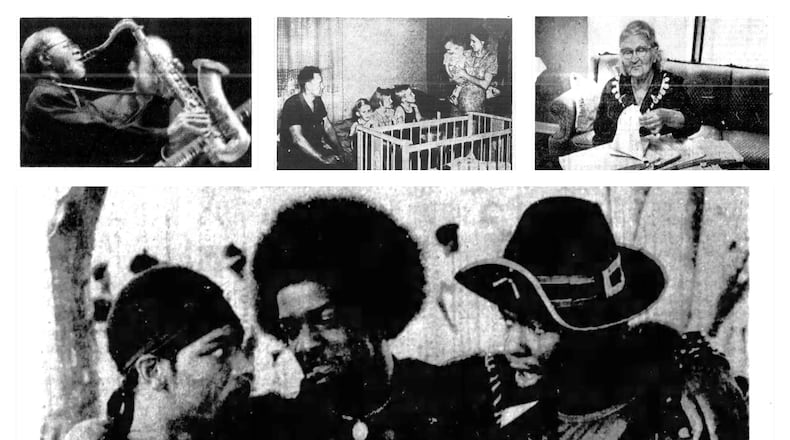Here’s a look at some stories from the week of July 14-20.
July 20, 1941: First tenants chosen for Parkside Homes; dedication set
Frank Fowler, his wife and their four children had the distinction of being the first tenants to move into one of the 604 low-rent apartments within Parkside Homes.
The federal housing project was nearing completion on the site of the former McCook Field.
A dedication ceremony was to be carried out under the direction of the Dayton Metropolitan Housing authority.
The Fowler family was chosen as an example of the type of low-income family the project was to help move from sub-standard living surroundings into the modern units which Parkside Homes was providing.
At opening, some 1,200 applications had been received by prospective tenants.
A family with three or more children with a peak income of $1,400 per year, could be accepted for a unit. Peak income for a family of two or three was $1,125 per year.
It was reported that the Fowler family would “enjoy all of the conveniences of a modern home at a cost of $19 a month, including all utilities.
Parkside Homes, a collection of dozens of subsidized apartment buildings, opened in 1941 but was demolished in 2007.
July 15, 1961: Grandmother, 75, copies Bible
Not too many people get around to reading the Bible all the way through, but a 75-year-old Dayton grandmother went one better.
She copied it.
“I had to write pretty fast, too — there’s a lot in the Bible, you know,” said the woman, whose name was given as “Mrs. Charles Ennis.
She had taken up the project six years earlier and had recently finished it, 31 paper tablets later.
Writing in pencil so she could erase her mistakes, s copied all of the Old and New Testament, using both sides of pages of paper. She added that her right shoulder was still hurting from all the writing.
July 18, 1971: Chains gang told to ‘Cool it’
In 1971, a special meeting was called between three Dayton gangs, the Dayton Panthers motorcycle club, the Panthers and Chains of Rap Brown.
The meeting, held at Mallory park, was to lay out some rules.
A group of Black youths, who were said to be Chains, attacked six white youths in Princeton park in lower Dayton View.
Ocie (Cricket) Curry, leader of the Panthers, spoke up, calling out the Chains.
“Seriously man, like everybody considers the gangs one group. The stuff about busting heads has got to stop. Police are getting hot on us. They know you are carrying pieces (guns) and your gonna get busted,” he said.
The Chains denied they were involved.
“That wasn’t us, somebody was just wearing our jackets,” one said. “They stole it. We don’t hang around Princeton, we stick around Residence park.”
Adults around Princeton Park had complained that their children are sometimes jumped by the Chains and that many kids were forced to join out of fear.
July 14, 1991: Lakeside Amusement Park amused thousands at century’s turn
The Dayton Daily News was taking a look back at Lakeside Park in 1991.
In 1898, 100,000 people were drawn to Lakeside Park’s roller coaster and other rides. There was also a hotel on the grounds.
Lakeside, first owned by E.J. Laterbach, lasted from 1890 to 1967. That era also included White City, Fairview Park and Forest Park.
The park was inspired by a cyclorama of the Battle of Gettysburg that had been built on the land the park ended up on. The 16,000-square-foot portrayal was 40 feet high and 320 feet in circumference.
In the cyclorama, a series of pictures or landscapes encircle the spectator to present a vast scene.
Even though it added a hotel, a roller coaster, water and other rides, by today’s standards, the park still wasn’t very large.
The park was located across the street from the Soldiers Home, as the VA Medical Center was then known.
July 15, 2001: ‘Homegoing Service’ pays tribute to world-renown saxophonist Joe Henderson
Services were held for Joe Henderson, a three-time Grammy-winning tenor saxophonist at Wayman Chapel A.M.E. Church in Dayton.
Henderson was a native of Lima but had been living in his adopted home of San Francisco.
The inventive performer died of heart failure at the age of 64.
During the service, a note from jazz pianist and composer Herbie Hancock was read. It said, in part, “Joe Henderson was one of the rare talents ... So profound had the presence of Joe Henderson been felt in the world, we will all be eternally grateful.”
Respected area-based musicians also showed their appreciation of the master player and composer, who until the last decade of his life was considered one of the jazz world’s best kept secrets.
Henderson was buried in Dayton National Cemetery, in recognition of his service in the U.S. Army.
About the Author






